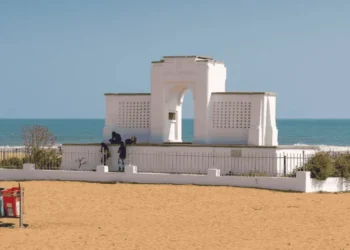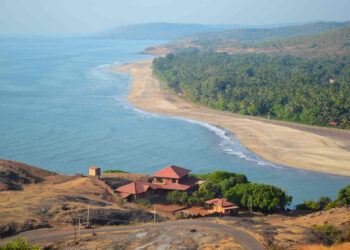In Udaipur, Rajasthan, a town famous for its lakes and old palaces, the Jagdish Temple is a holy place for Lord Vishnu, worshipped here as Jagannath, lord of all. Built in 1651, it sits close to the City Palace, pulling in devotees who pray and those who like its old carved stones. It shows Udaipur’s strong faith and Mewar’s proud past. This blog provides a detailed guide about the temple’s history, its legends, why it’s a big place for worship, it’s architecture, and what you need to know to visit the temple.
History of Jagdish Temple
The Jagdish Temple was built in 1651 by Maharana Jagat Singh I, a king of Mewar’s royal line. He paid 1.5 million rupees, a big sum then, to make a magnificient shrine for Lord Vishnu. Named after him, it was for Udaipur’s people to pray to Jagannath. The Mewar family kept it in good condition, and in the 1970s, the local community fixed it and added a rest house for pilgrims. Today, this group takes care of it, doing daily prayers. The temple is a main spot for worship in Udaipur and holds Mewar’s old honor.
Legend of the Temple
The Jagdish Temple has numerous tales that reflects its past. One local story says Maharana Jagat Singh had a dream where Lord Vishnu told him to build a temple in Udaipur. So, he made this shrine for Jagannath, like the divine temple in Puri, Odisha, but here it’s just for Vishnu, not his brother or sister. People say the black stone idol, carved from one rock near Udaipur, can answer prayers if you ask with a true heart. Another tale is about how the idol was made. Workers found a stone in a hill nearby, and when they carved it, it turned into Jagannath’s shape, like a sign from God. These stories, told by priests and people who pray here, give the temple a divine feel.
Why It Matters for Worship
The Jagdish Temple is a famous for prayer in Udaipur, especially for those who follow Lord Vishnu. People come to the black stone idol of Jagannath to ask for peace, good luck, or help with family troubles. It’s busiest during festivals like Janmashtami, when Lord Krishna’s birth is celebrated (he’s another form of Vishnu), and Diwali, when lamps light it up. Daily aartis at 6:00 AM, 12:00 PM, and 7:00 PM bring chants, bells, and incense smells. Devotees offer flowers, coconuts, and sweets, believing Vishnu’s blessings keep them protected. The temple lets in all people, no matter their caste or faith, showing Lord Vishnu’s love for all. Its tie to Mewar’s kings makes it a mark of faith and pride.
How the Temple Is Built
The Jagdish Temple is made in the Indo-Aryan style, set on a high platform with 32 marble steps to climb. Its tall top, called a shikhara, is 79 feet high, with carvings of gods, dancers, and elephants. The outer walls show Vishnu’s tales, like his ten forms, and parts of the Ramayana. The main hall has pillars with flower and animal designs, leading to the inner room where the black stone idol of Jagannath sits, dressed in silk and jewels. Smaller shrines for Lord Ganesha, Shiva, and the Sun God are nearby. A brass statue of Garuda, Vishnu’s bird, faces the idol. The temple’s white marble glows in the sun, and its spot near Lake Pichola makes it look mesmerizing.
Interesting Facts About the Temple
Made in 1651 by Maharana Jagat Singh I for 1.5 million rupees, a big sum then.
The black stone idol of Jagannath is said to grant wishes for true prayers.
The 79-foot shikhara has carvings of gods and tales, a treasure of Mewar art.
A brass Garuda statue stands before the idol, not common in Vishnu temples.
It’s right by the City Palace, tying it to Udaipur’s royal days.
Visiting Information for Jagdish Temple
How to Get There
The temple is in Udaipur’s old town, near the City Palace, about 20 kilometers from the airport and 2 kilometers from the train station.
By Air: Maharana Pratap Airport, 20 kilometers away, has flights from Delhi, Jaipur, and Mumbai. Taxis or autos take 30–40 minutes to the temple.
By Train: Udaipur Railway Station, 2 kilometers away, connects to Jaipur, Delhi, and Ahmedabad. Autos or taxis take 10 minutes.
By Road: Udaipur’s on NH-8, linking Jaipur (400 km) and Ahmedabad (260 km). Local buses, taxis, or autos from town get you there fast.
Temple Hours
The temple opens at 5:00 AM and closes at 10:00 PM every day. Aartis are at 6:00 AM, 12:00 PM, and 7:00 PM. During Janmashtami or Diwali, it might stay open longer. Ask temple workers about festival times.
Best Time to Go
November to February is best, with cool days, 10–25°C, good for visiting. Janmashtami in August and Diwali in October–November are full of prayers but busy. Summers, April to June, get hot, up to 40°C, so go early. Rainy months, July to September, can make roads wet, so plan ahead.
Rules for Visitors
Wear proper clothes: men need shirts, trousers, or dhotis with a cloth over the shoulder; women need sarees or churidar with a dupatta. Jeans, shorts, or sleeveless tops aren’t okay.
Take off shoes before going in. There’s a spot to keep them for Rs. 2 per pair.
No smoking, alcohol, or spitting allowed.
Ask priests before taking pictures in the main room.
No ticket needed to enter, but offerings for puja or aartis help the temple.
Bring water and a hat for the sun. Stalls nearby sell snacks, but don’t eat inside.
Watch for monkeys—they might grab food or bags if you’re not careful.
Nearby Places to See
City Palace: 200 meters away, a Mewar palace with museums and lake views.
Lake Pichola: 1 kilometer away, a fine lake with boat rides to Jag Mandir.
Bagore Ki Haveli: 500 meters away, an old mansion with folk dance shows.
Saheliyon Ki Bari: 3 kilometers away, a garden with fountains and lotus pools.
Final Words
The Jagdish Temple in Udaipur is a holy spot for Lord Vishnu and a mark of Mewar’s grand past. Its fine Indo-Aryan style and deep faith make it special. Whether you’re praying at an aarti, walking its carved steps, or seeing Udaipur’s lakes, visiting Jagdish Temple lets you feel Lord Vishnu’s blessings and touch Rajasthan’s rich history.











